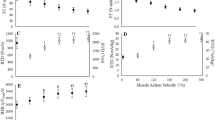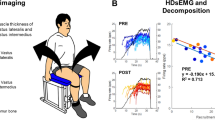Abstract
Purpose
This study evaluated the contributions of somatic maturity (years from estimated peak height velocity) and training experience as developmental indicators of muscle morphology, biomechanical parameters, and bilateral asymmetries in youth judo athletes.
Methods
Twenty-six judo athletes aged 8–18 years (mean ± SD; age = 12.9 ± 2.6 years, maturity offset = − 0.6 ± 2.2 years, training experience = 6.1 ± 2.9 years) completed anthropometric measurements, performance testing, and ultrasound evaluation of the vastus lateralis.
Results
Somatic maturity had the greatest relationship with handgrip performance (r2 = 0.76–0.80; p < 0.01) and lower-body plyometric ability (r2 = 0.23–0.72; p < 0.05). Somatic maturity and training experience accounted for 72% of the variance in hopping power. Bilateral asymmetries in average/peak force and 1-/2-s force–time integration during isometric handgrip increased with training experience (r2 = 0.17–0.46 p < 0.05). Muscle morphology (r2 = 0.29–0.75; p < 0.01) was best related to somatic maturity. Significant differences were found between child and adolescent judo athletes in force–time curve parameters, muscle morphology, and plyometric ability.
Conclusions
These results indicate that somatic maturity and training experience exert unique influences on muscle morphology, biomechanical parameters, and bilateral asymmetries in youth judo athletes.

Similar content being viewed by others
References
Fukuda DH, La Monica MB (2017) Youth development in combat sports. In: Drid P (ed) Science and medicine in combat sports. Nova Science Publishers, Inc., Hauppauge, pp 23–55
Albuquerque MR, Franchini E, Lage GM, Da Costa VT, Costa IT, Malloy-Diniz LF (2015) The relative age effect in combat sports: an analysis of olympic judo athletes, 1964–2012. Percept Mot Skills 121:300–308
Fukuda DH (2015) Analysis of the relative age effect in elite youth judo athletes. Int J Sports Physiol Perform 10:1048–1051
Franchini E, Takito MY (2014) Olympic preparation in Brazilian judo athletes: description and perceived relevance of training practices. J Strength Cond Res 28:1606–1612
Julio UF, Takito MY, Mazzei L, Miarka B, Sterkowicz S, Franchini E (2011) Tracking 10-year competitive winning performance of judo athletes across age groups. Percept Mot Skills 113:139–149
Fukuda DH, Stout JR, Kendall KL, Smith AE, Wray ME, Hetrick RP (2013) The effects of tournament preparation on anthropometric and sport-specific performance measures in youth judo athletes. J Strength Cond Res 27:331–339
Detanico D, Dal Pupo J, Franchini E, Giovana dos Santos S (2012) Relationship of aerobic and neuromuscular indexes with specific actions in judo. Sci Sports 27:16–22
Mangine GT, Fukuda DH, LaMonica MB, Gonzalez AM, Wells AJ, Townsend JR, Jajtner AR, Fragala MS, Stout JR, Hoffman JR (2014) Influence of gender and muscle architecture asymmetry on jump and sprint performance. J Sports Sci Med 13:904–911
Lloyd RS, Oliver JL, Hughes MG, Williams CA (2011) The influence of chronological age on periods of accelerated adaptation of stretch-shortening cycle performance in pre and postpubescent boys. J Strength Cond Res 25:1889–1897
Calmet M, Miarka B, Franchini E (2010) Modeling of grasps in judo contests. Int J Perform Anal Sport 10:229–240
Courel J, Franchini E, Femia P, Stankovic N, Escobar-Molina R (2014) Effects of kumi-kata grip laterality and throwing side on attack effectiveness and combat result in elite judo athletes. Int J Perform Anal Sport 14:138–147
Torres-Luque G, Hernandez-Garcia R, Garatachea N, Nikolaidis PT (2015) Anthropometric characteristics and neuromuscular function in young judo athletes by sex, age and weight category. Sport Sci Health 11:117–124
Bonitch-Gongora JG, Almeida F, Padial P, Bonitch-Dominguez JG, Feriche B (2013) Maximal isometric handgrip strength and endurance differences between elite and non-elite young judo athletes. Arch Budo 9:239–248
Sterkowicz S, Jaworski J, Lech G, Palka T, Sterkowicz-Przybycien K, Bujas P, Pieta P, Moscinski Z (2016) Effect of acute effort on isometric strength and body balance: trained vs. untrained paradigm. PLoS One 11:e0155985
Franchini E, Takito MY, Kiss MAPDM., Sterkowicz S (2005) Physical fitness and anthropometrical differences between elite and non-elite judo players. Biol Sport 22:315–328
Gutierrez Sanchez A, Soria Dominguez A, Perez Turpin JA, Cortell Tormo JM, Suarez Llorca C (2011) Importance of hand-grip strength as an indicator for predicting the results of competitions of young judokas. Arch Budo 7:167–172
Lech G, Jaworski J, Lyakh V, Krawczyk R (2011) Effect of the level of coordinated motor abilities on performance in junior judokas. J Hum Kinet 30:153–160
Ikemoto Y, Demura S, Yamaji S, Minami M, Nakada M, Uchiyama M (2008) Force-time parameters during explosive isometric grip correlate with muscle power. Sport Sci Health 2:64
Mirwald RL, Baxter-Jones AD, Bailey DA, Beunen GP (2002) An assessment of maturity from anthropometric measurements. Med Sci Sports Exerc 34:689–694
Lloyd RS, Cronin JB, Faigenbaum AD, Haff GG, Howard R, Kraemer WJ, Micheli LJ, Myer GD, Oliver JL (2016) National strength and conditioning association position statement on long-term athletic development. J Strength Cond Res 30:1491–1509
Feeley BT, Agel J, LaPrade RF (2016) When is it too early for single sport specialization? Am J Sports Med 44:234–241
Matthys SP, Vaeyens R, Coelho ESMJ., Lenoir M, Philippaerts R (2012) The contribution of growth and maturation in the functional capacity and skill performance of male adolescent handball players. Int J Sports Med 33:543–549
Silva S, Bustamante A, Nevill A, Katzmarzyk PT, Freitas D, Prista A, Maia J (2016) An allometric modelling approach to identify the optimal body shape associated with, and differences between Brazilian and Peruvian youth motor performance. PLoS One 11:e0149493
Lloyd RS, Oliver JL, Hughes MG, Williams CA (2009) Reliability and validity of field-based measures of leg stiffness and reactive strength index in youths. J Sports Sci 27:1565–1573
Sayers SP, Harackiewicz DV, Harman EA, Frykman PN, Rosenstein MT (1999) Cross-validation of three jump power equations. Med Sci Sports Exerc 31:572–577
Dalleau G, Belli A, Viale F, Lacour JR, Bourdin M (2004) A simple method for field measurements of leg stiffness in hopping. Int J Sports Med 25:170–176
Figueiredo AJ, Coelho e Silva MJ, Malina RM (2011) Predictors of functional capacity and skill in youth soccer players. Scand J Med Sci Sports 21:446–454
Malina RM, Eisenmann JC, Cumming SP, Ribeiro B, Aroso J (2004) Maturity-associated variation in the growth and functional capacities of youth football (soccer) players 13–15 years. Eur J Appl Physiol 91:555–562
Malina RM, Ribeiro B, Aroso J, Cumming SP (2007) Characteristics of youth soccer players aged 13–15 years classified by skill level. Br J Sports Med 41:290–295 (discussion 295).
Mikheev M, Mohr C, Afanasiev S, Landis T, Thut G (2002) Motor control and cerebral hemispheric specialization in highly qualified judo wrestlers. Neuropsychologia 40:1209–1219
Jacini WF, Cannonieri GC, Fernandes PT, Bonilha L, Cendes F, Li LM (2009) Can exercise shape your brain? Cortical differences associated with judo practice. J Sci Med Sport 12:688–690
Hibberd EE, Hackney AC, Lane AR, Myers JB (2015) Assessing biological maturity: chronological age and the pubertal development scale predict free testosterone in adolescent males. J Pediatr Endocr Met 28:381–386
O’Brien TD, Reeves ND, Baltzopoulos V, Jones DA, Maganaris CN (2010) Muscle-tendon structure and dimensions in adults and children. J Anat 216:631–642
Zaggelidis G, Lazaridis S (2013) Muscle activation profiles of lower extremities in different throwing techniques and in jumping performance in elite and novice greek judo athletes. J Hum Kinet 37:63–70
Monteiro LF, Massuca LM, Garcia JG, Carratala V, Proenca J (2011) Plyometric muscular action tests in judo- and non-judo athletes. Isokinet Exerc Sci 19:287–293
Buśko K, Nowak A (2008) Changes of maximal muscle torque and maximal power output of lower extremities in male judoists during training. Hum Mov 9:111–115
Franchini E, Brito CJ, Fukuda DH, Artioli GG (2014) The physiology of judo-specific training modalities. J Strength Cond Res 28:1474–1481
Sterkowicz-Przybycien K, Miarka B, Fukuda DH (2017) Sex and weight category differences in time-motion analysis of elite judo athletes: implications for assessment and training. J Strength Cond Res 31:817–825
Tucker R, Raftery M, Verhagen E (2016) Injury risk and a tackle ban in youth Rugby Union: reviewing the evidence and searching for targeted, effective interventions. A critical review. Br J Sports Med 50:921–925
Iglesias-Soler E, Mayo X, Dopico X, Fernandez-Del-Olmo M, Carballeira E, Farinas J, Fernandez-Uribe S (2018) Effects of bilateral and non-dominant practices on the lateral preference in judo matches. J Sports Sci 36:111–115
Pocecco E, Ruedl G, Stankovic N, Sterkowicz S, Del Vecchio FB, Gutierrez-Garcia C, Rousseau R, Wolf M, Kopp M, Miarka B, Menz V, Krusmann P, Calmet M, Malliaropoulos N, Burtscher M (2013) Injuries in judo: a systematic literature review including suggestions for prevention. Br J Sports Med 47:1139–1143
Koshida S, Deguchi T, Miyashita K, Iwai K, Urabe Y (2010) The common mechanisms of anterior cruciate ligament injuries in judo: a retrospective analysis. Br J Sports Med 44:856–861
Acknowledgements
We would like to acknowledge the efforts of Kayla M. Baker, David D. Church, Tyler W.D. Muddle, Joshua J. Riffe, and Alyssa N. Varanoske for their assistance in data collection.
Funding
Part of this work was supported by the Toni Jennings Exceptional Education Institute under a Research Projects Grant.
Author information
Authors and Affiliations
Corresponding author
Ethics declarations
Conflict of interest
The authors declare that they have no conflict of interest.
Ethical approval
The protocol was approved by the University’s institutional review board (IRB#: BIO-15-11061). All procedures performed were in accordance with the ethical standards of the institutional and/or national research committee and with the 1964 Helsinki declaration and its later amendments or comparable ethical standards.
Informed consent
Written parental consent and verbal participant assent were attained prior to participation.
Rights and permissions
About this article
Cite this article
Fukuda, D.H., Beyer, K.S., Boone, C.H. et al. Developmental associations with muscle morphology, physical performance, and asymmetry in youth judo athletes. Sport Sci Health 14, 555–562 (2018). https://doi.org/10.1007/s11332-018-0460-3
Received:
Accepted:
Published:
Issue Date:
DOI: https://doi.org/10.1007/s11332-018-0460-3




